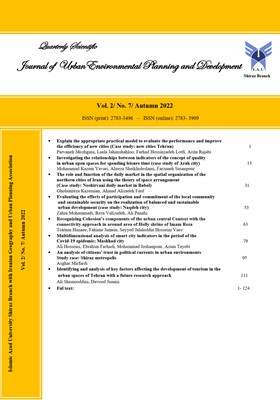بررسی روابط بین نماگرهای مفهوم کیفیت در فضاهای باز شهری برای گذران اوقات فراغت (مطالعه موردی : شهر اراک)
الموضوعات :
محمدکاظم یاوری
1
,
علیرضا شیخ الاسلامی
2
![]() ,
فرزانه ساسان پور
3
,
فرزانه ساسان پور
3
1 - دانشجوی دکتری شهرسازی، گروه شهرسازی، واحد بروجرد، دانشگاه آزاد اسلامی، بروجرد، ایران.
2 - استادیار گروه شهرسازی، واحد بروجرد، دانشگاه آزاد اسلامی، بروجرد، ایران.
3 - دانشیار گروه جغرافیا و برنامه ریزی شهری، دانشکده علوم جغرافیایی، دانشگاه خوارزمی، تهران، ایران.
الکلمات المفتاحية: اراک, فضاهای باز شهری, اوقات فراغت, نماگرهای کیفیت,
ملخص المقالة :
فضاهای باز شهری پتانسیل بالایی برای انواع فعالیت های شهری از جمله گذران اوقات فراغت دارند. این موضوع با رشد شهرنشینی و تغییراتی که در سبک زندگی شهروندان رخ داده، اهمیت بیشتری یافته و معرفی نماگرهای تبیین کننده مفهوم کیفیت در این فضاها و چگونگی روابط بین آنها می تواند برای برنامه ریزان شهری اهمیت ویژه ای داشته باشد. پژوهش حاضر، یک مطالعه توصیفی - تحلیلی با رویکرد کمی - کیفی است. در این تحقیق با درنظرگرفتن رابطه بین کیفیت فضاهای باز به عنوان هدف و شاخصهای عینی تبیین کننده آن، به عنوان نماگرهای مفهوم کیفیت، یک مدل ساختاری اندازه گیری پیشنهاد شده و چگونگی روابط بین نماگرهای معرفی شده و ضریب تاثیر آنها روی هدف پژوهش، با استفاده از تحلیل عاملی تاییدی مورد بررسی قرار گرفته است. بر اساس یافته های حاصله، از بین نماگرهای 45 گانه ای که در مطالعات تئوریک به عنوان نماگرهای مفهوم کیفیت در فضاهای باز شهری برای گذران اوقات فراغت احصاء گردید، 7 نماگر قدرت تبیین کنندگی لازم را نداشته و حذف شده اند و نماگرهای مفهوم کیفیت به تعداد 38 نماگر رسید. در بررسی روابط و چگونگی تاثیر گذاری و تاثیر پذیری این نماگرهای 38 گانه روی همدیگر ، مشخص گردید، 11 مورد از این نماگرها، با سایر نماگرها همبستگی ندارند. همچنین با بررسی بارعاملی محاسبه شده برای نماگرهای مذکور مشاهده گردید، نماگر وجود زمین و امکانات بازی و هیجان برای تمامی سنین با کسب ضریب تاثیر 66/0 ، بیشترین تاثیر را بر کیفیت فضاهای باز دارد. این نماگر جزء یازده شاخصی است که عملکرد مستقل و غیر همبسته دارد. همچنین برخی نماگرها مثل نماگر ابزار فعالیتهای سرگرمی، ورزش و آمادگی جسمانی با ضریب تاثیر 62/0 ، هر چند جزء شاخصهای 11 گانه مستقل نیست اما باز هم ضریب تاثبر بالایی به دست آورده است، این را می توان از این جهت توضیح داد که اهمیت شاخصهای 11گانه مستقل، به دلیل داشتن ضریب تاثیر بالاتر نیست، بلکه این اهمیت به دلیل مستقل بودن و عدم همپوشانی کاستی های احتمالی توسط سایر شاخص ها است، بنابراین مدیران و برنامه ریزان شهری باید نسبت به وضعیت آنها (نماگرهای مستقل) حساسیت بیشتری داشته باشند.
_||_


